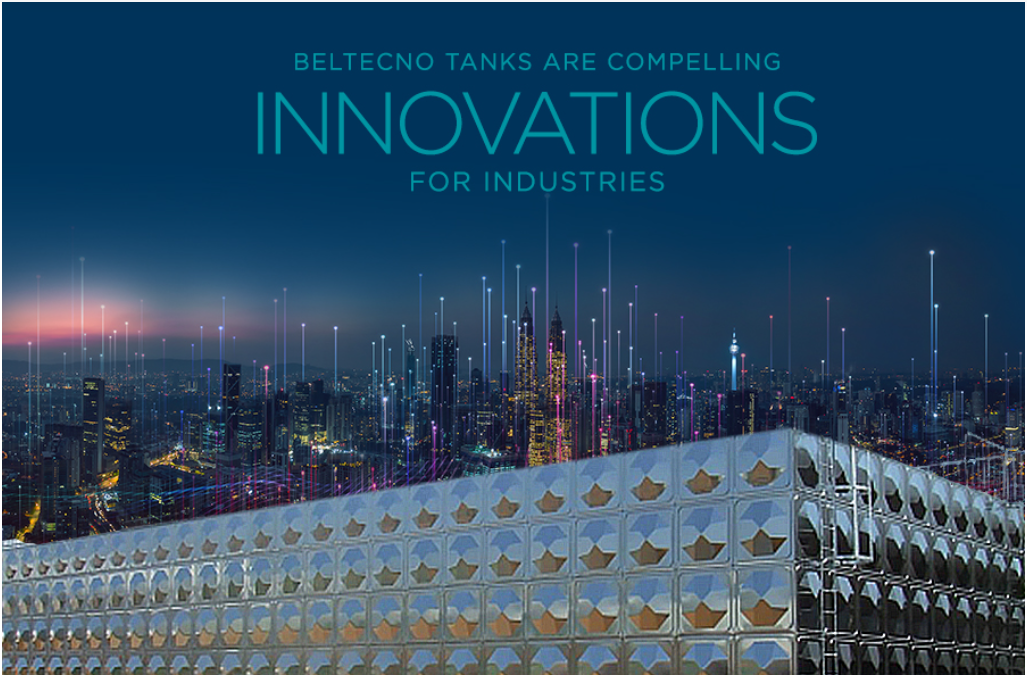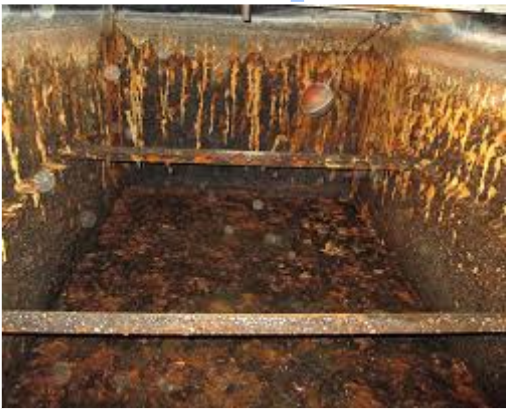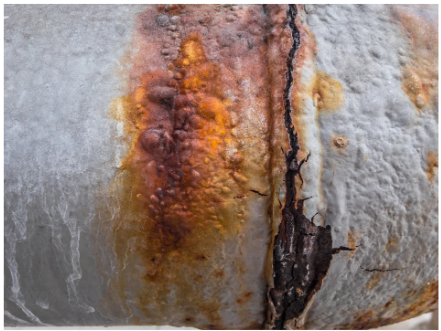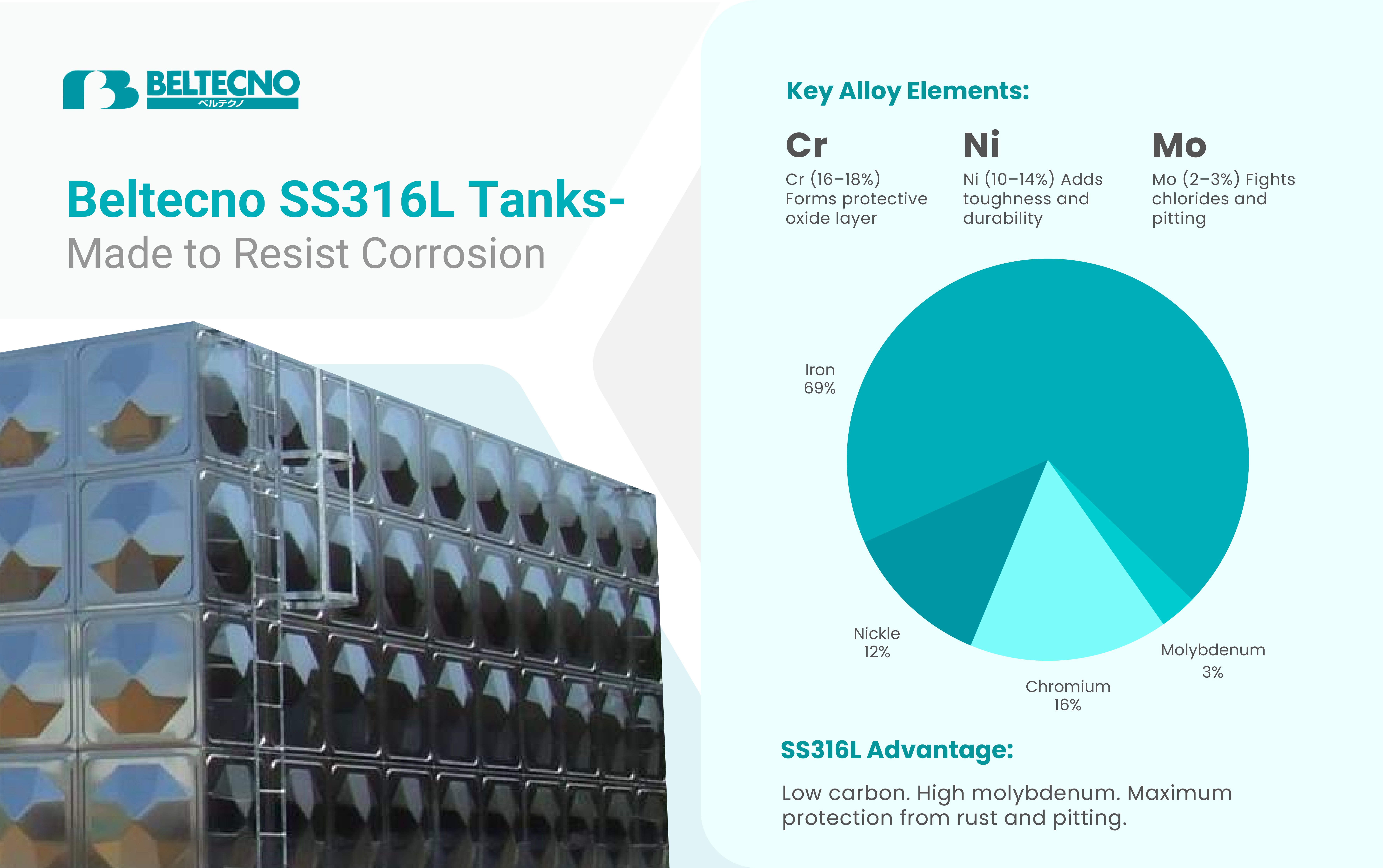How to Make Your Steel Water Tanks More Corrosion Resistant?

If you've invested in a stainless steel water tank, you've made a smart choice.
These tanks are tough, hygienic, and built to last. But here's something many people don't realise: Stainless steel is corrosion-resistant, but still can corrode under harsh or unsuitable environments.
The good news?
With a little knowledge and care, you can prevent corrosion and keep your tank in excellent shape for years.
In this blog, we are going to discuss how you can save your stainless steel water tanks from corrosion.
Why Does Stainless Steel Corrode Anyway?
You might be wondering, "Isn't stainless steel supposed to be rust-proof?" Well, not exactly.
Stainless steel becomes corrosion-resistant due to chromium, which forms a thin protective layer on the surface.
Think of it as an invisible shield that keeps rust far from stainless steel. But this shield isn't indestructible. Harsh chemicals, brine water, poor installation, and even contact with other metals can break down this protective layer, opening the door to corrosion.
If your industry or commercial space is near the coast or has water with high salt content, your tank faces extra challenges.
Add in factors like contamination from other metals, stress from improper installation, or just plain neglect, and you've got a recipe for corrosion problems down the line.
The Different Ways Your Tank Can Corrode
Not all corrosion looks the same. Understanding the different types can help you spot problems early and take action before they get serious.
1) Pitting Corrosion
Pitting corrosion is one of the most destructive forms of localised corrosion affecting stainless steel tanks.
It occurs when chlorides or other aggressive ions penetrate the protective chromium oxide layer, creating small holes or pits on the surface. These pits can grow deeper over time, eventually leading to leaks.
2) Crevice Corrosion

Crevice corrosion develops in confined spaces where oxygen cannot easily reach, such as under gaskets, at welded joints, or beneath deposits.
In these oxygen-depleted areas, the protective passive layer breaks down, causing localised attack. Poor design features like tight joints, overlapping surfaces, and stagnant water pockets create ideal conditions for this type of corrosion to flourish.
3) Galvanic Corrosion

Galvanic corrosion occurs when two dissimilar metals come into contact in the presence of an electrolyte like water.
The more active metal corrodes faster, while the nobler metal remains protected. This commonly happens when stainless steel tanks are connected to carbon steel pipes, copper fittings, or different stainless steel grades are welded together.
Even placing iron or steel tools on stainless steel surfaces for extended periods can transfer metal particles that disrupt the protective layer.
4) Stress Corrosion Cracking

This form of corrosion results from the combined effects of tensile stress and a corrosive environment.
It typically manifests as fine cracks that propagate through the metal, potentially causing sudden failure.
Factors contributing to stress corrosion cracking include residual stresses from welding, improper heat treatment, high chloride environments, and elevated temperatures.
How to Make Your Water Tank Corrosion Resistant?
The key to preventing corrosion is being proactive. Here's what actually works:
-
Start With The Right Material.
Not all stainless steel tanks are the same. For water tanks, SS316 or SS316L grades are significantly better than the more common SS304, especially if you're dealing with chlorinated water or salty conditions.
These higher grades contain molybdenum, which gives them extra resistance to pitting and crevice corrosion.
If you're in a coastal area or an industrial setting, it's worth the extra investment. Think of it as buying quality insurance for your water storage system.
-
Get The Installation Right.
This is where many problems start. Poor installation can cause issues that may appear years later.
Make sure your tank is installed by professionals who know what they're doing. The design should avoid creating pockets where water can stagnate or tight spots where corrosion can hide.
If your tank needs to connect to pipes or fittings made from different metals, use proper insulators to prevent galvanic corrosion. Pay attention to ventilation and drainage. These seemingly small details matter more than you might think.
-
Clean and Maintain Regularly.
This is probably the most important thing you can do, and it's something you completely control.
Set up a regular cleaning schedule and stick to it. Remove sediment, mineral deposits, and any biofilm buildup before they cause problems.
But be careful with what you use to clean the tank; harsh chemicals containing chlorides or abrasive scrubbers can damage the protective surface you're trying to preserve.
Look for discolouration, rust stains, or any surface irregularities. Catching issues early means fixing them before they become expensive disasters.
-
Consider Passivation Treatment.
This might sound technical, but it's basically giving your tank's protective layer a boost.
Passivation is a chemical treatment that removes iron contamination and enhances the natural chromium oxide layer.
It's especially important after installation or any major work on the tank. Think of it as resetting and strengthening your tank's natural defences.
-
Watch The Chlorine Levels.
While chlorine keeps water safe to drink, too much of it can attack stainless steel aggressively.
If you chlorinate your water, monitor the concentration carefully and avoid prolonged exposure to high levels.
The same goes for any cleaning chemicals; make sure they're compatible with stainless steel.
Stay away from products with hydrochloric acid, sulfuric acid, or strong bleaches. And always rinse thoroughly after using any chemicals.
The Long-Term Solution

If you want to truly minimise corrosion worries or need a corrosion-resistant water tank, invest in a high-quality tank from the start.
Modern stainless steel panel tanks, like those made by Beltecno using premium SS316L and advanced manufacturing techniques, offer exceptional durability.
These tanks have seamless designs that minimise those problematic crevices where corrosion starts.
Beltecno is a reputable manufacturer that will provide proper support and stand behind its products with solid warranties.
Read about: Stainless Steel Tank Features
FAQ About Corrosion in Water Tanks
Q1)How often should I clean my stainless steel water tank?
It is best to clean your water tanks twice a year. Other than this, weekly or monthly checkups can be done to notice potential corrosion spots or changes in the surface of the tank. These regular and timely maintenance help stainless steel water tanks to have a good lifespan.
Read about: Stainless Steel Water Tank’s Durability
Q2)How can you prevent stainless steel from corroding?
The steps and cautions mentioned in this blog will prevent any corrosion in your stainless steel water tank. Following these steps can save you a lot and will keep your water tank corrosion-resistant.
Q3)What are the signs of corrosion?
Different types of corrosion have different signs, but in general, if you notice red-brownish flakes, pitting, and small holes on the surface, these can be the initial signs of corrosion.
The Bottom Line
Protecting your stainless steel water tank doesn't have to be complicated, but it does require attention and care.
Choose quality materials, install properly, clean regularly, and stay vigilant for early warning signs. Prevention really is cheaper and easier than repair or replacement.
By taking these steps now, you're ensuring clean, safe water storage for decades to come and saving yourself from headaches and expenses down the road.
Remember, your water tank is a long-term investment in your business. Treat it right, and it'll serve you faithfully for years.
Want to get a corrosion-resistant stainless steel water tank? Contact Us
TES tanks run all the time. They control cooling water flow to manage temperature and cut energy costs. Emergency tanks work differently. They provide backup cooling water when the power goes out.
Beltecno can customize its tanks to store enough water for the recovery time in data centers. This gives reliable performance with solutions designed for each site.
Why Choose Welded Steel Storage Tanks Over Other Tank Types?
Welded steel storage tanks offer several advantages over other types of tanks, including bolted, concrete, and fiberglass tanks. Their unique construction process makes them a preferred choice across various sectors, including manufacturing, energy, and water treatment industries.
Here’s a breakdown of the benefits welded tanks provide compared to other options.
1. Seamless Construction Ensures Durability
One of the most significant advantages of welded steel storage tanks is their seamless construction.
Unlike bolted tanks assembled from many separate pieces, welded tanks are built as one solid structure.
This design removes weak points where leaks can happen. It also helps the tank last longer and reduces the need for maintenance.
Welded tanks are built to withstand pressure fluctuations, corrosion, and wear, making them ideal for industrial applications.
2. Superior Resistance to Environmental and Chemical Corrosion
Stainless steel, an alloy known for its corrosion resistance, is the material of choice for stability are invaluable. Welded steel storage tanks can safely store both hot and cold energy. They offer a dependable option for industries that want a sustainable way to manage their energy use.
TES tanks store hot or cold energy during off-peak hours, optimizing energy usage and reducing costs.
3. Customizable Designs for Diverse Industrial Needs
Unlike pre-fabricated tanks, welded steel storage tanks are highly customizable. They can be designed to fit specific capacity, shape, and dimensional requirements, making them suitable for unique operational needs.
Welded steel storage tanks can be designed to handle high pressure and tough environmental conditions. They can meet the strict demands of many industrial processes. This flexibility is particularly useful for industries like manufacturing, where space constraints and custom storage needs are common.
How Thermal Energy Storage Works?
TES systems store energy as heat or cold for later use. When energy demand is low, they use the extra energy to create heat or cold and then store it in tanks filled with water or a phase change material.
When energy demand peaks, the stored thermal energy is released, reducing the load on traditional power sources. This load management is especially beneficial for energy-intensive industries, where energy costs fluctuate widely.
Why Are Welded Steel Storage Tanks Ideal for TES?

TIG welding is very effective for making welded steel storage tanks used in thermal energy storage systems. It offers high precision and strong welds, which are important for tanks that must handle heat and pressure.
This method uses a tungsten electrode and an inert gas like argon or helium to protect the weld from contamination. The welds are clean, smooth and durable, with very few defects.
TIG welding reduces problems like porosity and small gaps that can cause heat loss or leaks. This is important for TES systems because even small flaws can affect temperature control and reduce energy efficiency.
The smooth and corrosion resistant weld seams also help the tank handle repeated heating and cooling cycles. This improves the long term performance of tanks that store both hot and cold energy.
Because TIG welding creates strong and precise joints, the entire tank stays stable under high temperatures and pressure. The method also works well with stainless steel, which has low thermal conductivity. This reduces the need for extra insulation.
Overall, TIG welding and stainless steel make welded tanks highly efficient for TES. They help preserve stored energy, maintain steady temperatures and support clean, energy saving industrial operations.
The Importance of Welded Steel Storage Tanks in India’s Infrastructure Development
India’s industrial sector is growing fast, and that growth puts real pressure on the country’s energy and water resources. As India moves toward its sustainability goals, the need for smarter, more efficient infrastructure becomes hard to ignore.
Welded steel storage tanks, especially those designed for thermal energy storage, fit neatly into this shift. They support cleaner energy use, reduce waste and help industries cut their overall environmental footprint.
Addressing Water and Energy Demands
Welded steel storage tanks are also widely used for storing water, a critical resource in industrial and commercial settings. Their corrosion-resistant properties make them ideal for ensuring clean, uncontaminated water storage. Additionally, by incorporating TES systems, industries can reduce their dependence on non-renewable energy sources and contribute to a more balanced energy grid.
Meeting Industrial Standards and Compliance
Industries in India are subject to stringent environmental regulations, making compliance a significant factor in storage solutions.
Welded steel storage tanks meet high safety and hygiene standards, making them compliant with regulations in sectors like pharmaceuticals, food processing, and manufacturing. Stainless steel tanks offer the benefit of easy maintenance and frequent sanitization.
Long-Term Cost Savings
The upfront cost of welded steel storage tanks can be higher than other options, but they tend to pay for themselves over time. Their long service life and low maintenance needs cut down on unexpected repairs and replacement expenses.
Industries also see fewer disruptions, which keeps operations running smoothly. For companies that value sustainability and steady performance, welded steel storage tanks are a practical and financially smart choice.
Welded Steel Storage Tanks: A Step Towards Sustainable Energy Management
Choosing welded steel storage tanks for TES and other industrial uses reflects a clear move toward cleaner and more efficient infrastructure.
These tanks make it easier to store thermal energy, which helps industries tap into renewable sources more effectively and support global sustainability efforts.
Sectors like power, manufacturing, and food processing gain a lot from this approach. When companies invest in welded steel storage tanks, they strengthen their operations while cutting down their overall energy use. It’s a practical step that supports India’s broader focus on sustainable growth.
Read more about the use of thermal storage tanks in data centers to go green & efficient.
Conclusion
Welded steel storage tanks offer unmatched durability, corrosion resistance, and thermal efficiency, making them the ideal choice for industries that require reliable storage solutions. Their application in thermal energy storage further enhances their value, enabling businesses to manage energy more effectively and support sustainable practices.
As India’s industrial landscape expands, welded steel storage tanks are becoming essential for meeting rising energy and water storage needs. Their long-lasting, sustainable performance makes them a vital part of modern infrastructure.
By choosing Beltecno welded steel storage tanks, industries can ensure they’re investing in quality, sustainability, and the future of energy management.
If you want to learn more about how we can assist you in getting your perfect SS tank please Contact Us.